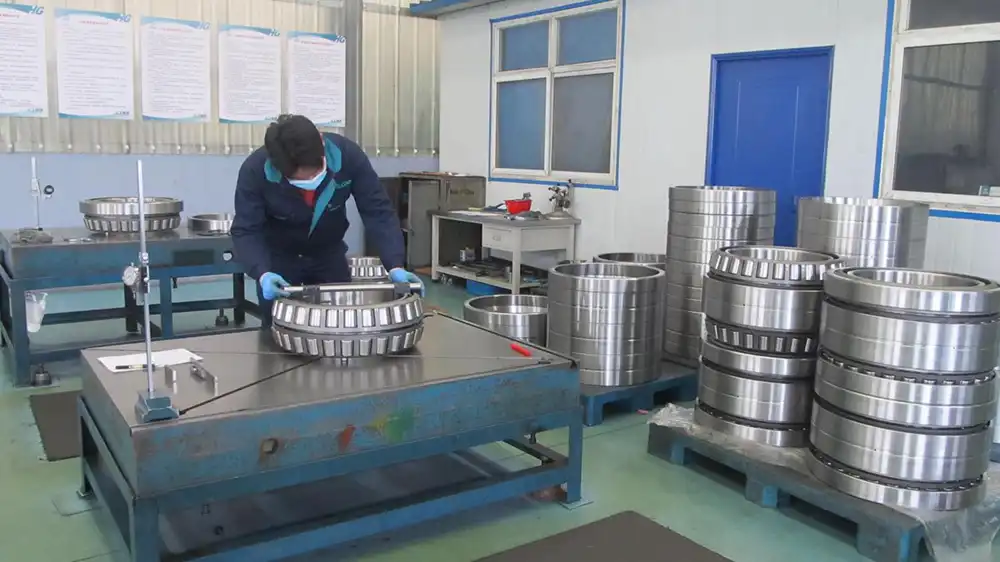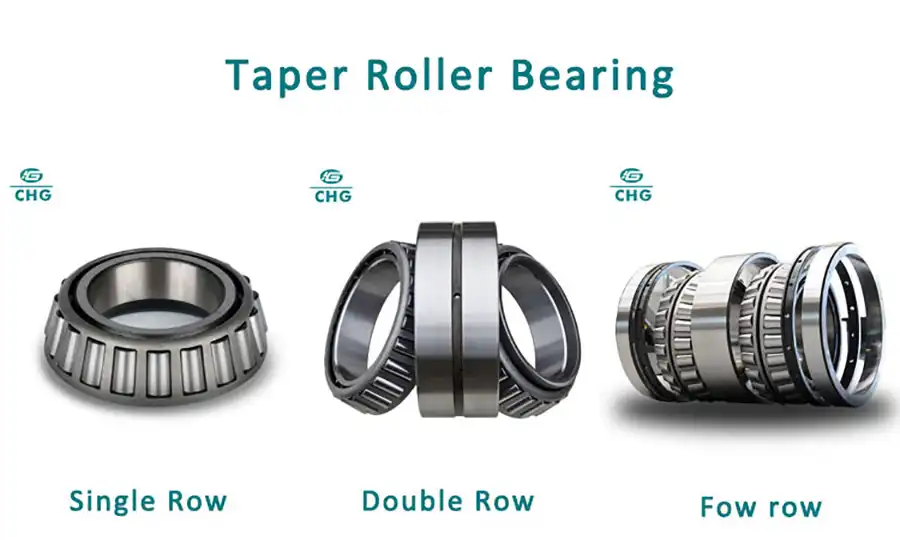What Maintenance is Required for Single Row Tapered Roller Bearings?
Single row tapered roller bearings are sophisticated mechanical components that play a vital role across numerous industrial applications, from automotive powertrains and industrial gearboxes to heavy construction equipment and mining machinery. These precision-engineered elements consist of tapered rollers guided by a cage between inner and outer rings (races), designed to handle both radial and axial loads simultaneously. Their unique design makes them particularly suitable for applications where combined loading occurs, but this also necessitates careful attention to maintenance procedures to ensure optimal performance and maximize service life.

How Often Should Tapered Roller Bearings Be Lubricated?
The lubrication maintenance of Single Row Tapered Roller Bearings requires careful consideration and systematic approach due to their unique geometry and load-bearing characteristics. These bearings, with their distinctive tapered rollers arranged between inner and outer raceways, demand particular attention to lubrication practices as they typically handle both radial and axial loads simultaneously. The establishment of an optimal lubrication schedule becomes crucial for maintaining their operational integrity and extending service life, particularly given their widespread use in automotive axles, industrial gearboxes, and heavy machinery applications.

In standard operating conditions where Single Row Tapered Roller Bearings function within moderate speed ranges and ambient temperatures, a general recommendation is to perform relubrication every 3,000 operating hours or at six-month intervals, whichever comes first. However, this baseline schedule requires adjustment based on specific application parameters. For instance, in high-speed applications exceeding 3,000 RPM, where the tapered geometry can generate additional heat due to sliding contact between roller ends and rib surfaces, more frequent lubrication intervals become necessary. Similarly, when these bearings operate under heavy loads that exceed 70% of their dynamic load rating, the lubricant film becomes more stressed, necessitating shorter intervals between lubrication cycles.
Environmental factors play a significant role in determining the appropriate lubrication frequency for Single Row Tapered Roller Bearings. When exposed to harsh conditions such as excessive dust, moisture, or chemical contaminants, these bearings may require weekly or even daily lubrication attention. The tapered design, while excellent for handling combined loads, can be particularly susceptible to contamination infiltration at the larger end of the roller assembly, making proper sealing and regular lubrication crucial for preventing premature wear. In temperature-controlled environments, such as climate-controlled manufacturing facilities, standard lubrication intervals may be extended, provided that regular monitoring confirms stable operating conditions.

The implementation of modern monitoring techniques has revolutionized lubrication maintenance for Single Row Tapered Roller Bearings. Infrared thermography, ultrasonic monitoring, and vibration analysis provide valuable data that can help optimize lubrication schedules. These technologies are particularly beneficial for tapered roller bearings due to their ability to detect early signs of inadequate lubrication, which often manifests as increased friction and heat generation at the roller-raceway contact points. Additionally, automated lubrication systems, when properly calibrated for the specific requirements of tapered roller bearings, can deliver precise amounts of lubricant at predetermined intervals, ensuring consistent protection while minimizing the risk of over-lubrication.
Proper lubrication technique is as important as timing when maintaining Single Row Tapered Roller Bearings. The process should begin with thorough cleaning of grease fittings and surrounding areas to prevent contaminant introduction. When applying new lubricant, it's crucial to use only manufacturer-recommended grades that meet the specific requirements of tapered roller bearings, particularly in terms of viscosity and extreme pressure additives. The lubricant should ideally be applied while the bearing rotates at low speed to ensure even distribution across the tapered surfaces. Careful attention must be paid to avoid over-lubrication, as excess grease can lead to increased operating temperatures and accelerated degradation of the lubricant, particularly problematic in the confined spaces of tapered roller bearing assemblies.
Establishing a comprehensive maintenance program for Single Row Tapered Roller Bearings should include detailed record-keeping of all lubrication activities, regular training of maintenance personnel, and the implementation of condition-based monitoring systems. This systematic approach, combined with proper handling and storage of lubricants, ensures optimal bearing performance and maximizes service life. Regular review and adjustment of lubrication schedules based on operating data and bearing performance metrics help maintain the effectiveness of the maintenance program while optimizing resource utilization and reducing unexpected downtime.
What Are the Signs of Tapered Roller Bearing Failure?

Tapered roller bearings, particularly single row variants, exhibit distinct warning signs when approaching failure that maintenance professionals must carefully monitor. The most immediate and noticeable indicator often manifests as abnormal acoustic signatures, where bearings may produce grinding, squealing, or clicking sounds that deviate from their typical operational noise profile. These sounds frequently intensify during load changes or speed variations, potentially indicating compromised roller-to-raceway contact surfaces or inadequate lubrication conditions. The acoustic characteristics can range from subtle changes in normal operating sounds to pronounced high-frequency emissions, particularly when the bearing experiences insufficient lubrication or early-stage surface deterioration.
Vibration patterns serve as crucial diagnostic indicators in single row tapered roller bearings, with excessive vibration often detectable through specialized monitoring equipment. These bearings may display characteristic frequency patterns that correspond to specific component interactions between the tapered rollers, inner race, outer race, and cage assembly. The vibration signatures typically become more pronounced as damage progresses, with distinct directional components that can reveal misalignment issues or mounting irregularities specific to the tapered configuration.
Temperature monitoring provides valuable insights into bearing health, with single row tapered roller bearings typically maintaining optimal performance below 82°C. Deviations from normal operating temperatures, especially uneven thermal distribution across the bearing housing, often indicate developing problems. The tapered geometry of these bearings makes them particularly sensitive to proper lubrication and loading conditions, with temperature spikes frequently signaling inadequate lubrication flow across the roller-raceway interfaces or excessive preload conditions.
Visual inspection of single row tapered roller bearings can reveal various deterioration signs, including surface damage patterns like spalling or pitting on the tapered rollers and raceways. The unique geometry of these bearings makes them susceptible to specific wear patterns, particularly when experiencing misalignment or improper loading. Heat-induced discoloration, especially blue or brown tinting on roller surfaces or raceways, indicates severe operating conditions that may have compromised the bearing's metallurgical properties. Additionally, the condition of lubricants and seals provides crucial information about the bearing's operating environment and potential contamination issues.
Performance degradation in equipment utilizing single row tapered roller bearings often manifests through increased power consumption and reduced operational efficiency. The precision-dependent nature of these bearings means that even minor damage can result in noticeable impacts on equipment function, potentially leading to quality issues in the final product or process. Irregular rotation or excessive clearance can develop as wear progresses, particularly affecting the critical tapered interfaces that provide both radial and axial load support.
Modern condition monitoring approaches for single row tapered roller bearings incorporate multiple analysis techniques for comprehensive health assessment. Regular vibration analysis, combined with thermal imaging and oil analysis programs, provides detailed insights into bearing condition. These methods can detect early-stage damage before it progresses to catastrophic failure, allowing maintenance teams to plan interventions effectively. The integration of various monitoring techniques, particularly acoustic emission analysis for detecting microscopic surface damage, enables a thorough understanding of bearing health throughout its service life.
How Can You Extend the Service Life of Tapered Roller Bearings?
To maximize the service life of single row tapered roller bearings, proper installation is paramount and begins with the use of appropriate installation tools, including induction heaters and hydraulic mounting devices that ensure precise mounting without damaging the bearing components. During installation, achieving correct alignment is critical and can be accomplished using modern laser alignment systems, while proper preload settings must be carefully verified and documented according to the manufacturer's specifications. The installation process demands meticulous attention to cleanliness and the use of properly maintained tools to prevent contamination that could compromise bearing performance.
Environmental control plays a crucial role in bearing longevity, particularly for single row tapered roller bearings which are sensitive to contamination and moisture. Implementing effective sealing solutions and filtration systems helps maintain clean operating conditions, while controlling ambient humidity levels prevents moisture-induced corrosion that can significantly impact bearing life. The operating environment should be regularly monitored and maintained, with particular attention paid to temperature control and protection from external contamination sources through well-designed housing systems.
Operational considerations for single row tapered roller bearings focus on maintaining proper operating parameters within the manufacturer's specifications. This includes adhering to speed limits, avoiding excessive loading conditions, and ensuring continued proper alignment throughout operation. Regular monitoring of operating temperatures and implementation of smooth start-up procedures helps prevent premature failure due to shock loading or thermal stress. Continuous monitoring of operating parameters enables early detection of potential issues before they develop into serious problems.
A comprehensive preventive maintenance strategy is essential for extending bearing service life. This involves developing and following detailed maintenance schedules based on specific operating conditions and regular inspections using appropriate diagnostic tools. Maintenance personnel should be thoroughly trained in proper inspection techniques and the use of modern monitoring tools for predictive maintenance. All maintenance activities should be meticulously documented to facilitate trend analysis and continuous improvement of maintenance procedures.
Proper storage and handling procedures are critical for preserving the integrity of single row tapered roller bearings before installation. Bearings should be stored in controlled environments with appropriate temperature and humidity levels, and handled only with clean tools or properly protected hands to prevent contamination. Maintaining original packaging until installation and implementing first-in-first-out inventory practices helps ensure bearings are not compromised during storage. Regular inspection of stored bearings helps identify any signs of corrosion or damage before installation.
Performance monitoring represents the final crucial element in maximizing bearing service life. This involves regular assessment of bearing performance through appropriate metrics, trend analysis of operating parameters, and comprehensive documentation of operating conditions and any changes. Regular equipment audits help verify compliance with established procedures, while the implementation of reliability metrics provides valuable data for maintenance planning and continuous improvement of bearing maintenance practices. Integration of monitoring data into maintenance planning ensures a proactive approach to bearing maintenance and helps prevent unexpected failures.

Luoyang Huigong Bearing Technology Co., Ltd. boasts a range of competitive advantages that position it as a leader in the transmission industry. Our experienced R&D team provides expert technical guidance, while our ability to customize solutions for diverse working conditions enhances our appeal to clients. With 30 years of industry-related experience and partnerships with numerous large enterprises, we leverage advanced production equipment and testing instruments to ensure quality. Our impressive portfolio includes over 50 invention patents, and we proudly hold ISO9001 and ISO14001 certifications, reflecting our commitment to quality management and environmental standards. Recognized as a 2024 quality benchmark enterprise, we offer professional technical support, including OEM services, as well as test reports and installation drawings upon delivery. Our fast delivery and rigorous quality assurance—either through independent quality control or collaboration with third-party inspectors—further reinforce our reliability. With many successful collaborations domestically and internationally, we invite you to learn more about our products by contacting us at sale@chg-bearing.com or calling our hotline at +86-0379-65793878.
References
1. SKF Bearing Maintenance Handbook (2021). SKF Group, Sweden.
2. Timken Engineering Manual (2023). The Timken Company, USA.
3. Harris, T.A., & Kotzalas, M.N. (2022). Essential Concepts of Bearing Technology. CRC Press.
4. NSK Technical Report: Bearing Maintenance (2023). NSK Ltd., Japan.
5. Schaeffler Technical Guide (2023). Schaeffler Technologies AG & Co. KG, Germany.
6. ISO 15243:2017 Rolling bearings - Damage and failures - Terms, characteristics and causes.
7. NTN Technical Review (2023). NTN Corporation, Japan.
8. JTEKT Engineering Journal (2023). JTEKT Corporation, Japan.
9. American Bearing Manufacturers Association (2023). Bearing Maintenance Guidelines.
10. International Journal of Mechanical Engineering (2023). "Advanced Techniques in Bearing Maintenance", Vol. 45, Issue 3.

